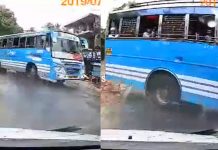Driving is the controlled operation and movement of a motor vehicle, including cars, motorcycles, trucks, and buses. Permission to drive is granted based on a set of conditions being met and drivers are required to follow the established road and traffic laws in the location they are driving.
Driving in traffic is more than just knowing how to operate the mechanisms which control the vehicle; it requires knowing how to apply the rules of the road (which ensures safe and efficient sharing with other users). An effective driver also has an intuitive understanding of the basics of vehicle handling and can drive responsibly.
Although direct operation of a bicycle and a mounted animal are commonly referred to as riding, such operators are legally considered drivers and are required to obey the rules of the road. Driving over a long distance is referred to as a road trip.
Kerala Little Boy Playing as a Bus Driver
Physical skill : A driver must have physical skills to be able to control direction, acceleration, and deceleration. For motor vehicles, the detailed tasks include: Starting the vehicle’s engine with the starting system, Setting the transmission to the correct gear,
Depressing the pedals with one’s feet to accelerate, slow and stop the vehicle and
If the vehicle is equipped with a manual transmission, to modulate the clutch,
Steering the vehicle’s direction with the steering wheel, Applying brake pressure to slow or stop the vehicle, Operating other important ancillary devices such as the indicators, headlights, parking brake and windshield wipers, Observing the environment for hazards.
Mental skill : Avoiding or successfully handling an emergency driving situation can involve the following skills: Making good decisions based on factors such as road and traffic conditions, Evasive maneuvering, Proper hand placement and seating position,
Skid control, Steering and braking techniques, Understanding vehicle dynamics,
Right- and left-hand traffic.



















